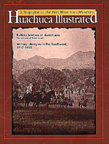 Huachuca
Illustrated, vol 1, 1993:
Huachuca
Illustrated, vol 1, 1993: Huachuca
Illustrated, vol 1, 1993:
Huachuca
Illustrated, vol 1, 1993:
chuca Illustrat
chuca Illustrat
Buffalo Soldiers at Huachuca:
Events in the 1920s
chuca Illustrat
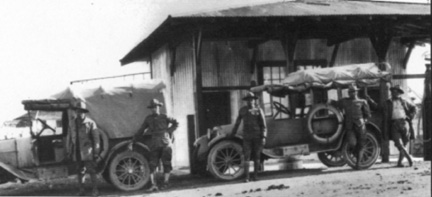 The Buffalo Bulletin was not above outright
fawning when it came to the regiment's self-interest. In its April 30,1921,
edition it announced the arrival of the Inspector General of the Department
and said of him: "He is our idea of what an I.G.D. should represent.
Helpful, courteous, a thorough soldier and Cavalryman, he is the most welcome
Inspector we know of."
The Buffalo Bulletin was not above outright
fawning when it came to the regiment's self-interest. In its April 30,1921,
edition it announced the arrival of the Inspector General of the Department
and said of him: "He is our idea of what an I.G.D. should represent.
Helpful, courteous, a thorough soldier and Cavalryman, he is the most welcome
Inspector we know of."
10th Cavalrymen gassing up their Army trucks. From the Markel Collection.
Flattery like this may have helped, for the admiration was mutual. In his report of the inspection dated May, 1921, the I.G., Lt. Col. W. V. Morris, wrote on behalf of Major General Dickerman, commander of the VIII Corps area:
Colonel E. B. Winans, Tenth Cavalry, is worthy of commendation for the improvement in the condition of the Tenth Cavalry since the last annual inspection. The appearance, uniformity, and completeness of equipment were excellent. To Colonel Winans is also due much of the credit for the excellent morale and esprit of the regiment. On the whole, I consider the Tenth Cavalry to be as good and in some respects better than the Thirteenth Cavalry, which up to this time was in the best condition of any regiment I had ever inspected.
A soldier with pickup truck in the Chiricahua Mountains in 1919. From the Markel Collection.
Colonel Winans passed the credit along to the regiment in an endorsement, saying, "...The officers and men are entitled to equal share in the credit, for without their cooperation such a showing would have been impossible."
Lieutenant Richmond was proud of having one of the few cars on Fort Huachuca in 1921. He said, "...There were only two cars on post, mine, a Studebaker Special 6 Touring model, and one Model T. ...I purchased a putmobile roadster which was put on a flat car at Riley and shipped down here. The roadster was not too good."(37-38)
In 1921, according to one officer, "there was one train a day which came up at eleven o'clock. We called it the Huachuca Jackrabbit"
Captain Clarence Richmond described some other of the activities of the regiment at Huachuca in 1921.
... Besides garrison duty, we rode trails all over and made night marches to Tombstone and the Empire Ranch over in the Whetstones, Benson, St. David, Nogales back and forth. Sandy McNabb was the one who wrote the marksmanship manual. ...He was in command of the 25th and Winans of course was in command of the 10th until he left and then Hugh B. Myers, Lt. Colonel Hugh B. Myers took command; he was a big fellow who weighed about 240 lbs. We used to exchange visits when the 25th stayed at Nogales.(39)
On the morning of December 7,1922, a DeHavilland DH-4B aircraft was reported missing on a flight from San Diego to Tucson. The pilot was Lt. Col. Charles L. Webber of the Army Air Service and his passenger was Col. Francis C. Marshall, Deputy Chief of Cavalry, who was scheduled to inspect the Reserve Officer Training Corps detachment at the University of Arizona. The 10th Cavalry from Fort Huachuca with their Apache Scouts, the 25th Infantry stationed at Camp Stephen D. Little in Nogales, and the 12th Observation Squadron from Fort Bliss participated in the search for the aircraft. They found nothing. The wreckage and bodies were found in the spring in the hills just above San Diego.
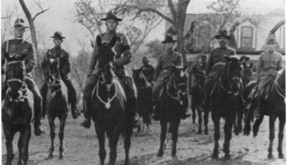
Colonel Edwin B. Winans, Commanding the 10th Cavalry,
and staff at Fort Huachuca in 1921.
Captain Clarence Richmond talked about the search for the missing aircraft in the Santa Cruz Valley.
... We were down in front of the stables on a Sunday morning on the 22d of December 1922, waiting for a call from the Executive Officer of the Chief of Cavalry's Office, Colonel Marshall. He was coming in from San Diego with a pilot by the name of Lieut. Webber for an inspection of the post. He didn't arrive...so we got word in here to take the field and hunt for him. ...We had only a couple of hours to get started, and we had one pack train here. My troop was assigned to go to this ranch on the other side of the Huachucas. We had Capt. Floyd H.L. Ryder, in command of the squadron. He's now a retired real estate agent in Monrovia, California. He headed for the Empire Ranch over in the Whetstones. Well, on Monday and Tuesday, my Troop, C split up into small patrols and covered the other side of the Huachuca Mountains. With us were a couple of Apache Scouts on their Indian ponies. In the morning if I wanted one deer, two deer or three deer, I'd hold up my fingers and by eleven or twelve o'clock, they would be in with those deer.
... I received orders on Tuesday afternoon at four o'clock to proceed to Mansfield Mine up from Patagonia, a distance of sixty-five miles road distance which we made on Wednesday and covered the west slope of the Patagonians. Since we only had one pack train, and it was so far from the Empire Ranch, the Squadron Commander couldn't send any food over, Sgt Peterson, the mess sergeant and myself went.out with our Springfields and knocked over a few slow deer. We assigned the Apache Indian Scouts to bring us in the venison each day and we stayed there for about fifteen days. Then I got orders to come in from Mansfield Mine, that the search for Colonel Frank C. Marshall and Lieut. Webber was over; they were found several months later fifty miles from San Diego where they had cracked up in a fog against a mountain peak. The plane had burned and there was nothing left except metal and their skeletons.
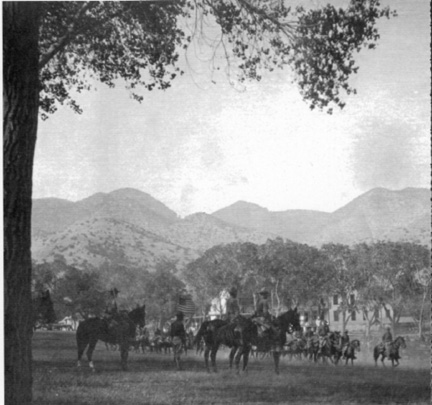
10th Cavalry review in 1921.
In an 1959 interview, veteran 10th Cavalry officer Clarence Richmond talked about the inspection of the regiment made by General Pershing.
I might mention another vivid episode of my service at Huachuca. General Pershing was making a last inspection trip just before he retired from active service and having served with the 10th Cavalry, he was scheduled to make a stop at Huachuca. He stayed over night at the quarters of the Commanding Officer, Colonel Edwin B. Winans, and he was suppose to make a quick departure from the Post after the inspection, and the entire regiment formed at the commander's house on the parade field. ...The center of the regiment was, with the colors, directly in front of the Commanding Officer's quarters, the center set of the old adobe quarters. We expected the Commanding Officer and General Pershing to come on out immediately. As we formed it was snowing and very cold. Instead of coming out immediately at 7:05 or thereabouts, we stood there and close to 9:00 o'clock the General and Commanding Officer came out for inspection. Instead of galloping madly from right to left, front and rear of the troops, General Pershing having served with the 10th, he went from troop to troop at the walk and shook hands with many of the old time soldiers who he had known during his service with the 10th Cavalry. As he got to the end of the line, you could hear a rumble and a mumble; we'd have to stay inspection over because most everybody was freezing to death. I've never fogotten that inspection.(40)

10th Cavalry inspection in 1922.
The 10th Regiment came in for some more praise on January 26,1923, when the commander of the Ist Cavalry Division at Fort Bliss, Texas, Maj. Gen. Robert L. Howze, wrote:
On the eve of this separation of the 10th Cavalry Regiment from the Ist Cavalry Division, I desire to express to you my appreciation of the loyal cooperation and the fine spirit of helpfulness that your regiment has displayed throughout its service as a member of the division.
The high state of training and the excellent morale that has prevailed in your organization has served to reflect credit not only upon the regiment and its commander, but upon the division of which it was a part.
Will you please convey to your officers and men my regrets that tactical reasons should have made this separation advisable.(41)
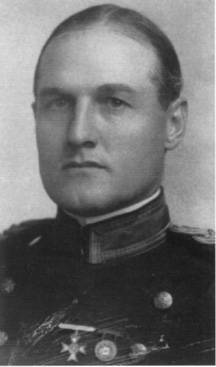 A report by the commanding officer for 1925 details
some of the rigors of training that was undergone by the enlisted men that
year. One hundred and thirty-three recruits were taken into the regiment
and were put through the paces of recruit training. In addition to the usual
post schools, troop NCO schools, remount groups, and equitation classes,
there were several field problems, regimental maneuvers, and even a joint
drill with Hollywood movie makers. These are best described by Col. James
C. Rhea, commanding.
A report by the commanding officer for 1925 details
some of the rigors of training that was undergone by the enlisted men that
year. One hundred and thirty-three recruits were taken into the regiment
and were put through the paces of recruit training. In addition to the usual
post schools, troop NCO schools, remount groups, and equitation classes,
there were several field problems, regimental maneuvers, and even a joint
drill with Hollywood movie makers. These are best described by Col. James
C. Rhea, commanding.
James Cooper Rhea
The regiment as a whole passed through the ordinary training cycle during the year, with maneuvers to match. May 9-13 found the regiment operating with planes from the 2d Division in working out problems of coordination and cooperation and the use of cover. During the march to Douglas for the Defense Day ceremonies, the squadrons were pitted against each other for maneuvers in driving one another through the various canyons of the Huachucas.... Patrols were sent out from 60 to 70 miles on successive days. September 10-25 was spent in regimental maneuvers in the vicinity of Ash Canyon. There followed joint maneuvers with our rivals, the 25th Foot. [The 25th Infantry Regiment was stationed at Camp Stephen D. Little at Nogales at this time.] Unbiased members of the press tossed laurels to the 10th Horse, much to the dejection of the Doughboys. The 72-hour continuous problem that initiated the relations proved hectic to the self-termed Sore Feet, but left us jaded. Less fatiguing problems ensued until all terminated in the annual tactical inspection by the Corps Area Commander. Comments and criticisms by the Corps Area Commander and his staff were very complimentary concerning the training and efficiency of the regiment.
There was but one major diversion during the year. This occurred when the Fox Film Corporation sent a troupe down on location to film The Golden Strain. Apaches were brought in from Fort Apache, once garrisoned by troops of the regiment, to augment our local ti band of Indian Scouts. The usual fictious fights, plunderings and maraudering took place, with the soldiers featuring as heroes par excellence. The stellar luminaries of the cinema being truly attractive, we were afforded some delightful hobnobbing that-will be long remembered.(42)
Memories of past glories and unted sports were all that remained to the horse solders of the 10th Cavalry in the 1920s at Fort Huachuca. Horsemanship was still highly prized and the troopers sharpened their riding skills by participating in equestrian events and polo matches. The polo team from Fort Huachuca was among the Army's best and won many trophies in Army-wide competition.

10th Cavalry officers at Fort Huachuca in November
1925. Front row, left to right: Capts. Maas, Fuller, (Veterinarian) Domblazer,
Fontain, (Medical) Amest, (Medical) Baker, Col. George Grunert, Col. James
Cooper Rhea, Maj. Chapin, Lieutenants Schjerven, Swift and Wrenn. Back row,
left to right: Lieutenants Nelson, Williams, Capts. Taylor, Scott, Shamron,
Evereft, Lts. John H. Healy, Fake, Capt. Lisle, Lieut. Biddle, Lieut. Kirk
Broaddus, Connor, Maddox, Pitts, thomas, Clausen, and Chaplain Cover. Photo
courtesy Mrs. Kirk Broaddus.
Horse shows were held periodically and judged by Cavalrymen of other regiments. An example of the types of awards given can be seen in the 1926 report which records that the Duggan Cup was won by Private Haddox for the best turned out in the enlisted men's class, the Douglas Chamber of Commerce Cup for the best Cavalry horse went to Private Mackey, the Palmer Cup was awarded to Sergeant Jackson for the best enlisted man's mount, Sergeant Pearson astride Snake won the enlisted men's jumping, and Sergeant Jackson again was the winner of the Johansen Cup for individual point winner. In March and April 1929, revolution in Mexico threatened American lives along the border and Brig. Gen. Frank S. Cocheu set up headquarters at Fort Huachuca to patrol the border, using 18 airplanes in addition to his troops.(#43)

Members of the 10th Cavalry polo team at Fort Huachuca
in 1925. From left to right: 1st Lieut.J6hn H. Healy, Major Frank K. Chapin,
Lieut. Halley C. Maddox, Capt. Taylor, Lieut. George C. Clausen, 1st Lieut.
Kirk Broaddus. Photo courtesy Mrs. Kirk Broaddus.
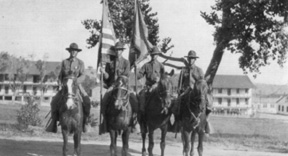 ---
---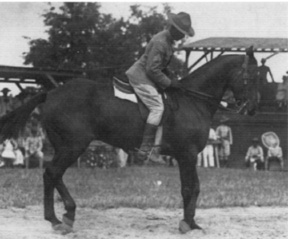
Color guard at Citizens Military Training Camp, Fort
---------------A
sergeant of the 10th Cavalry puts his mount
Huachuca, 1926. Holding the unit flag is George W. Parker,---------------through his paces in a 1920 equestrian competition.
a member of a pioneer family for whom Parker Canyon Lake---------------U.S. Army photo.------------------------------------------
is named. Photo courtesy George W. Parker.------------------------------------------------------------------------------------------
 U.S. Army Lifestyles
at Huachuca in the 1920s: Food
U.S. Army Lifestyles
at Huachuca in the 1920s: Food
Pvt. Tom Prowl of B Troop sat down in 1922 to a Christmas dinner of oyster soup, shrimp salad with Giovanni dressing, candied sweet potatoes, creamed peas, pickled beets, baked corn, roast turkey with giblet gravy and a boiled Southfield ham. For dessert there were mince pies, pumpkin custard, layer cake, raisin pies, ice cream, apples, oranges, bananas, nuts, and candies. The final course consisted of beer and cigars. The Army did not consider anything with less than 1.4 percent alcohol content as an alcoholic beverage, and therefore allowed "near beer" during prohibition years.(#44)
-------
.
Private Tom Prowl, 10th Cavalry, in a studio pose.
Photo courtesy Prowl Collection, Fort Huachuca Museum.
Footnotes:
37. Richmond, Col. Clarence W., Ordnance officer, 409 18th Street, Santa Monica, CA, interview, 1959. Typescript in Fort Huachuca Museum files. He served with the 1 Oth Cavalry at Fort Huachuca from 1921 to 1923. He transferred from the 9th Cavalry where he had been regimental Personnel Adjutant and at Huachuca became Provost Marshal. Right after World War II he returned to Huachucal as an advisor to the Arizona National Guard.
41. Howze letter, dated 26 January 1923, in FHM files
42. The Rasp: The Cavalry Service Annual, The Cavalry School, Fort Riley, Kansas, 1926, 156-9.
43. Ganoe, William A., History of the United States Army, Appleton-Century, NY, 1924, 492.